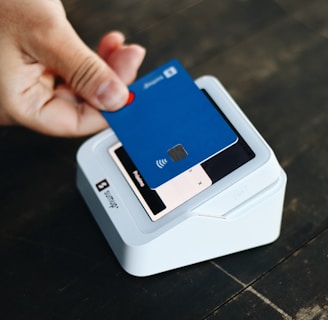How Do I Get Paid?
ACHCREDIT CARDSPAYMENTMERCHANT PROCESSING
Courtney Beck
8/18/20214 min read


When we decide that we want to be our own boss and take on the grand adventure of owning our own business, we can get caught up in the little details that help to run that business. One of those rather large details is how in the world do I get paid?? There are so many different invoicing systems and merchant processors, that it can be difficult to choose the best plan for your needs. Below you will find a few of the more common ways to invoice and get paid.
Cash/ Check
This is one of the more obvious options, but it is limited in nature. For one, you have to physically take the money to the bank (which equals extra time). You also have to keep a cash drawer because there are few customers that carry exact change at all times. With checks comes the increased liability of payment not going through and unless you are good friends with the check writer, it can be difficult to chase down a bounced check payment. Quite honestly, we are living in a digital age, where most people rely on digital forms of payment. In order to grow your business and be relevant with your customers, it is prudent to offer other forms of payment processing alongside cash.
So as we think about digital payment processing, we want to make sure that it is secure, reliable, and low cost. Unfortunately, payment processing fees are just part of doing business. It is important to note that although Venmo, Cash App, Paypal, and Zelle all have a fee-free account, if you are caught doing business transactions with those, it can lead to fines and even being blocked from using the account. Venmo and Paypal do offer business accounts though!
PayPal
PayPal has several different merchant options to choose from. For myself and most of my clients, we don’t need the robust PayPal Pro or customized plans. However the two that would be most beneficial are the Standard and the Zettle accounts. The Standard is your basic “Here’s an invoice, please pay it.”. This works great for virtual services or if you invoice customers for products. Zettle is the card reader, which includes a QR Code! For in person events, craft shows, farmers markets, etc. this would be a good option.
Venmo for Business
It is well known and used among people and can be really handy for trade jobs such as landscaping and carpentry along with mom and pop style businesses (think home bakeries, handmade products, etc). Because Venmo just recently launched the business account, the reports aren’t the greatest when it comes to accounting and since there are no integrations yet (that I am aware of), all reports have to be downloaded and then finagled into the accounting software. It’s possible, but just not the most bookkeeper friendly.
Stripe
This is actually the merchant account I personally use within my business. Why? Because it integrates with Xero (my accounting software), which makes month end reconciliations a breeze! The fees and the payments are both matched to my invoices and I don’t have to resort to journal entries for the fees. It does not however have a direct integration to QuickBooks, so one would need to use the reports download to account for the fees.
Square
Square is one of the more well known processing softwares in the business world. One of the neat aspects about Square is that you can also use it for inventory and as an online storefront. They also have a good P.O.S hardware that allows you to take payments wherever you are. I find this a great resource for brick and mortar stores! There are additional costs for using the retail features, but it is still a great resource nonetheless.
It’s also important to note that many accounting softwares are beginning to roll out their own merchant accounts. QuickBooks Payments and Wave Accounting both allow for you to send an invoice and be paid all within the same system which cuts down on needing an integration and/ or journal entries.
There are even more options than what I have shared! But I do believe that this shorter list can help the start up business navigate through their different options when it comes to being paid.
Elevation is about partnering with the small business and if you would like to learn more about the Bookkeeping Start-Up Plan which can help not only get your bookkeeping set up, but also help you pick a merchant account that would be right for your business. Click here for more information.
Merchant Fee Recap
Paypal- Standard
2.9% + $0.30 per transaction (ACH and Debit/Credit)
PayPal- Zettle
Upfront $29 for 1 card reader
2.29% + $0.09 per transaction (Debit/Credit Card)
3.49% + $0/09 per transactions (Manual Entry)
1.9% + $0.10 (transactions over $10.01) (QR Code)
2.4% + $0.05 (transactions $10 and under) (QR Code)
Venmo
1.9 % + $0.10 per transaction (Debit/ Credit)
5.00% for checks (minimum $5)
Square
1% (minimum $1) (ACH)
2.9 % + $.30 per transaction (Debit/ Credit)
3.5% + $0.15 per transaction (includes card on file) (Manual Entry)
Stripe
0.8% per transaction (ACH)
2.9 % + $.30 per transaction (Debit/ Credit)
QuickBooks Payments
1% ($10 max)
2.9% + $0.25 invoiced (Debit/ Credit)
2.4% + $0.25 swiped (Debit/ Credit)
3.4% + $0.25 (Manual Entry)
Wave Payments
1% ($1 minimum) (ACH)
2.9% + $0.30 Visa, Mastercard, and Discover
3.4% + $0.30 for American Express
Disclaimer #1: I am not an affiliate for any of these companies, but I do use many of them in some form or another.
Disclaimer #2: Prices are subject to change! As of August 1, 2021 these are the prices that were displayed on each company’s website. If you are reading this and the prices have changed, let me know so I can update.
